renewable energy
A Just Energy Transition: Getting Decarbonisation Right in a Time of Crisis – review
In A Just Energy Transition: Getting Decarbonisation Right in a Time of Crisis, Ed Atkins argues for prioritising social over technical considerations in decarbonisation policies and sets out six principles for a just and sustainable transition. Focusing on the UK, the book makes a strong case for decarbonisation initiatives that centre community participation, worker inclusion and global equity, writes Sibo Chen.
A Just Energy Transition: Getting Decarbonisation Right in a Time of Crisis. Ed Atkins. Bristol University Press. 2023.
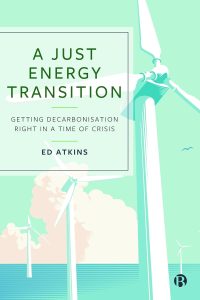 As momentum for decarbonisation grows worldwide, how can the transition to renewable energy be made in a just and equitable manner? In response to this vital question of environmental politics, A Just Energy Transition by Ed Atkins is a timely contribution that delineates the multiple facets of the concept of a “just energy transition”. The book criticises the dominance of technical considerations over social and political ones in current policy discussions regarding decarbonisation. It urges greater scholarly and public attention to the elements that render decarbonisation unfair and undemocratic. Accordingly, its analytical focus is on “what a just energy transition should be” rather than “why such a transition is necessary.”
As momentum for decarbonisation grows worldwide, how can the transition to renewable energy be made in a just and equitable manner? In response to this vital question of environmental politics, A Just Energy Transition by Ed Atkins is a timely contribution that delineates the multiple facets of the concept of a “just energy transition”. The book criticises the dominance of technical considerations over social and political ones in current policy discussions regarding decarbonisation. It urges greater scholarly and public attention to the elements that render decarbonisation unfair and undemocratic. Accordingly, its analytical focus is on “what a just energy transition should be” rather than “why such a transition is necessary.”
[A Just Transition] criticises the dominance of technical considerations over social and political ones in current policy discussions regarding decarbonisation
The book’s arguments are laid out in nine chapters. In Chapter One, Atkins contextualises the injustice inherent in the ongoing energy transition in the UK through a detailed account of how mounting energy expenses pose an urgent challenge to many households. With energy affordability having been largely overlooked in the development of renewable energy infrastructure thus far, many vulnerable and marginalised communities feel left “stranded” when renewable energy infrastructure is developed in their surroundings. Thus, Atkins argues that in order to achieve a just energy transition, protecting potentially “excluded” communities worldwide and offering them new possibilities for prosperity (like means to reduce living costs) is as important as phasing out fossil fuels.
Atkins contextualises the injustice inherent in the ongoing energy transition in the UK through a detailed account of how mounting energy expenses pose an urgent challenge to many households.
Chapter Two delves deeper into the operationalisation of a policy framework for just energy transition through an examination of the interrelationships between just transition, energy justice, and energy democracy. Recognising how current decarbonisation planning has been dominated by elite stakeholders, the chapter advocates for a government-led yet community-centred approach to the roll-out of renewable energy infrastructure. According to Atkins, this approach needs to prioritise the original “just transition” concept’s call for coalition building between climate activists and workers, marginalised communities’ call for participation in the decision-making process of energy projects and for the investments in renewable energy to engender structural and transformative reforms. To accomplish these objectives, energy transition initiatives should incorporate principles including distributive justice, procedural justice and recognition justice.
In subsequent chapters, Atkins details how different forms of energy injustice overlap and coincide with one another, drawing upon cases in the UK context. This analysis underscores the need for moving beyond thinking of opposition to renewable energy projects as “Not-In-My-Neighbourhood” (NIMBY)-ism. Instead, the opposition to and support for new landscapes resulting from decarbonisation by communities and residents reflects broader issues and narratives. Atkins outlines six rules that bring together the reduction of emissions, the support for vulnerable households, and the empowerment of communities.
First, he advocates for community-scale energy projects. While the imperative of decarbonisation necessitates the large-scale development of renewable energy projects, the placement of these projects in rural areas frequently gives rise to “green sacrifice zones” that inflict harm upon rural communities. To mitigate such distributive injustice, a just energy transition can include small renewable energy facilities directly benefiting their adjacent communities. These community-centred projects, supported by community investment as well as financial and technical aid from the state, enable the production of electricity that is owned by the local community and mitigate the negative effects of landscape disruption.
[Public] consultations tend to fail short in empowering people and communities in the decision-making process.
Second, he suggests that participation and voices of communities be amplified when developing new energy projects. Renewable energy projects commonly seek to obtain the support and approval of their host communities by means of public consultations. Yet, as evidenced by the local opposition to several wind turbine projects in the UK, such consultations tend to fail short in empowering people and communities in the decision-making process. Procedural injustice manifests itself when local residents are merely seen as passive recipients of reimbursement and compensation and bystanders of electricity generation, with little thought given to concerns such as energy access and landscape disruptions. Accordingly, community-level ownership ought to be considered in a just transition, as it not only fosters local support and buy-in but cultivates positive relationships among community members.
A notable advantage of community and public-owned renewable energy projects is their capacity to strengthen local economies. Stigmatisation affects communities grappling with energy poverty, as their lack of capacity to engage in energy transition initiatives (often attributable to substantial upfront infrastructure expenses) is misrecognised. Recognition justice entails respecting the variations among local stakeholders in terms of their motivations, priorities, experiences, and actions. Atkins thus calls for the foregrounding of community-centred energy schemes in local economies. Community Municipal Investments, which connect low-emission or renewable energy infrastructure to residents who require assistance, are a crucial tactic for advancing recognition justice.
Amid the escalating costs of energy, many households are unable to finance retrofitting projects designed to improve energy efficiency
A fourth priority is to provide for those most vulnerable to energy poverty. Amid the escalating costs of energy, many households are unable to finance retrofitting projects designed to improve energy efficiency. Recognising the vulnerability of these households while prioritising their needs fulfils the call for restorative justice. Given their substantial influence on the fundamental rights of households to heat and light, decarbonisation initiatives must prioritise energy availability, accessibility, and sustainability.
Atkins’ fifth call is to Ensure the participation and inclusion of workers. Providing better livelihoods and working conditions for workers is a key goal of the early advocates for just transition. In the UK, however, past, and current renewable energy projects have not fully realised this promise. As of now, the employment opportunities generated through decarbonisation are predominantly precarious, characterised by hazardous work environments and inadequate salaries in comparison to identical positions in the oil and gas sector. A long-term approach to green skills and employment that is attentive to worker-led action and voices is vital.
Ongoing decarbonisation initiatives in developed countries risk shifting the negative impacts of energy transitions to the Global South.
Lastly, the author stresses that a just energy transition in the UK must be achieved in a way that advances energy justice everywhere. Cosmopolitan (energy) justice, defined in the book as “linking low-carbon transitions to a broader understanding of global injustice(s)” (30), underscores that ongoing decarbonisation initiatives in developed countries risk shifting the negative impacts of energy transitions to the Global South. As evidenced by the escalation of illegal mining (eg, cobalt in the Democratic Republic of Congo and gold in Peru and Colombia) and waste disposal (eg, electronic waste dumped to countries such as India and Pakistan), the expanding demand for raw materials driven by renewable energy infrastructure poses a particular threat to the living conditions of communities situated on the periphery of global climate politics. To achieve an energy transition that incorporates the principle of cosmopolitan justice, decarbonisation needs to be reframed from a global perspective, reckoning with both the historical responsibility of developed countries for emissions as well as the entrenched injustices associated with colonialism.
Atkins’ advocacy for examining decarbonisation through the lenses of the urban-rural divide and global injustice offers valuable insights for future research development.
In sum, A Just Energy Transition elucidates the major theoretical discussions pertaining to the relationship between decarbonisation and social justice. Grounded in environmental justice theories, it proposes six principles crucial to accomplishing a just energy transition. The book’s discussion of the root factors of NIMBYism and the wide-ranging repercussions of energy poverty are comprehensive and convincing. Atkins’ advocacy for examining decarbonisation through the lenses of the urban-rural divide and global injustice offers valuable insights for future research development. Although the book’s exclusive focus on the UK restricts the generality of some of its arguments, it remains an informative resource for scholars and students intrigued by the political and social implications of decarbonisation.
This post gives the views of the author, and not the position of the LSE Review of Books blog, or of the London School of Economics and Political Science. The LSE RB blog may receive a small commission if you choose to make a purchase through the above Amazon affiliate link. This is entirely independent of the coverage of the book on LSE Review of Books.
Image Credit: I Wei Huang on Shutterstock.
The New Mexico Electricity Co-op Breaking Up With Fossil Fuels
This story was originally published by High Country News.
In 2006, Luis Reyes Jr., CEO of Kit Carson Electric Cooperative, an electricity distribution cooperative in northern New Mexico, was in a bind. On one side, clean energy proponents were pushing him to add more renewables. On the other, Kit Carson’s energy supplier, Tri-State Generation and Transmission, was doubling down on coal. Worse, the co-op’s contract with Tri-State — which barred it from producing more than five percent of its own energy — wouldn’t end until 2040.
“That was really the start of the breakup,” Reyes said.
Kit Carson’s ensuing separation from Tri-State, which took nearly a decade, was driven by the persistence of its members. Unlike investor-owned utilities, which are controlled by shareholders, rural distribution co-ops answer to the households and businesses that use the energy.
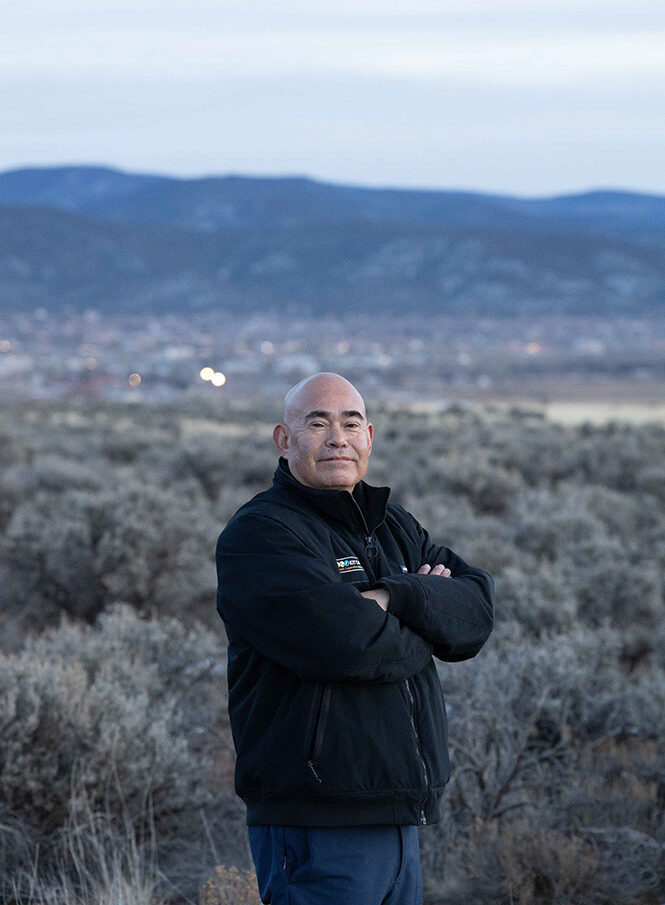 Luis Reyes Jr., CEO of Kit Carson Electric Cooperative. Credit: Juan Antonio Labreche / High Country News
Luis Reyes Jr., CEO of Kit Carson Electric Cooperative. Credit: Juan Antonio Labreche / High Country News
A product of the New Deal, Kit Carson was founded in 1944 to bring electricity to rural northern New Mexico. Today, there are 832 rural distribution co-ops nationwide.
In general, rural co-ops rely more on coal and have moved more slowly toward decarbonization than large investor-owned utilities. But that’s changing, with Kit Carson leading the charge. Co-op members worried about climate change are leveraging the distinctly democratic governing structures of rural distribution co-ops to encourage decarbonization. Robin Lunt, chief commercial officer at Guzman Energy, Kit Carson’s current energy supplier, called co-ops “a great bellwether” for shifting public opinion.
“They’re much closer to their communities,” she said, “and to their customers, because their customers are their owners.”
But democracy is messy, and change can take years. Lunt praised Reyes’ patience and persistence at Kit Carson, while Reyes credits the committed, vocal co-op members who pushed it to be “good stewards … of the land and water.” Still, the job is far from done, as the co-op continues its struggle to phase out fossil fuels entirely.
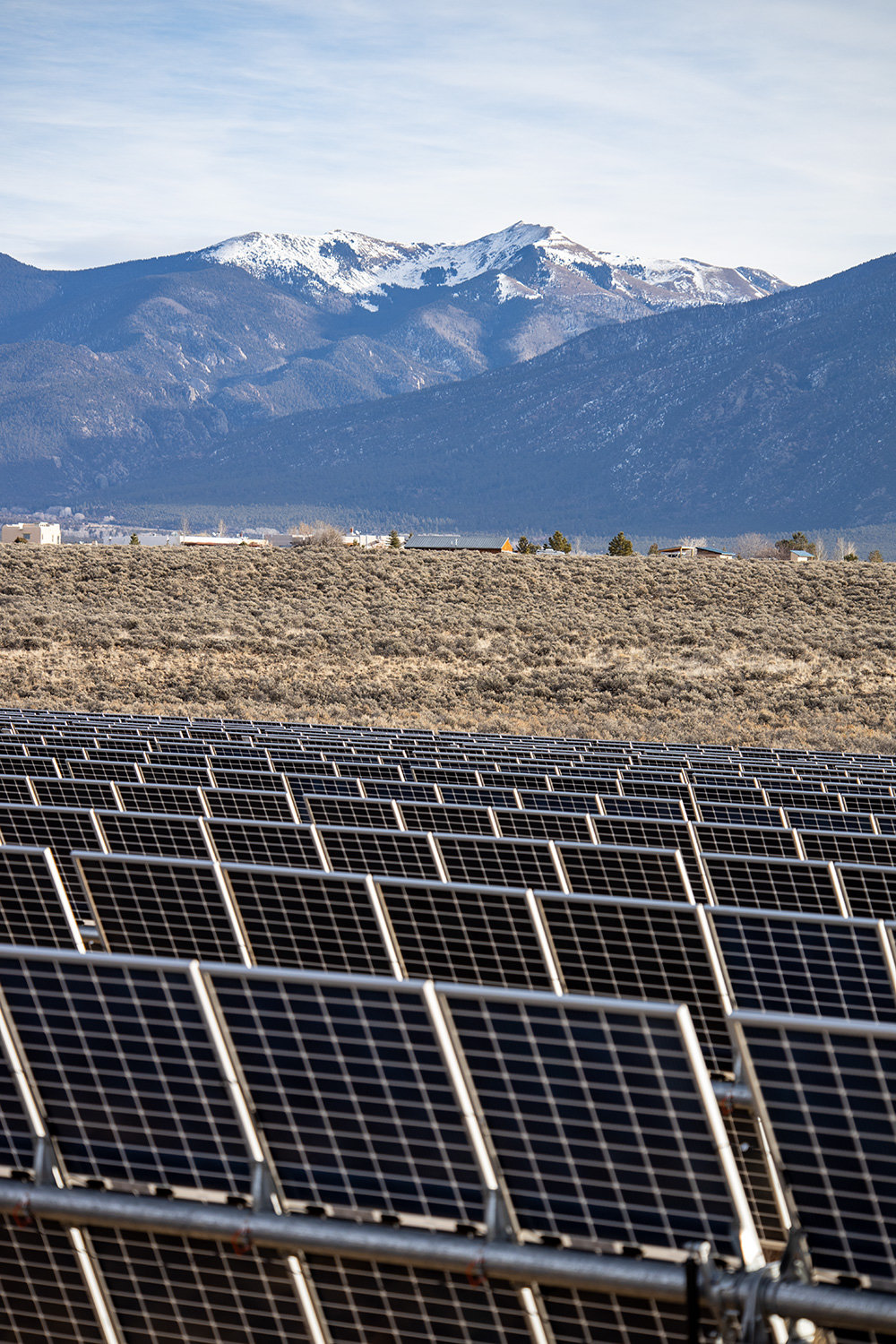 Kit Carson’s largest solar array, near Taos, New Mexico. Juan Antonio Labreche / High Country News
Kit Carson’s largest solar array, near Taos, New Mexico. Juan Antonio Labreche / High Country News
Reyes was raised in Taos, in a home powered by Kit Carson. He was with his mother one day when she paid her bill at the co-op office. A manager offered Reyes a job, which he took after graduating from New Mexico State in 1984 with a degree in electrical engineering. A decade later, he became CEO.
The early 2000s found the co-op trying to expand its offerings in rural areas and launch internet services. Tri-State was also trying to grow, and, in 2006, it announced plans to build a large coal plant in Kansas. It also wanted Kit Carson to extend its contract until 2050, adding another decade. It was around this time, Reyes said, that some members started asking “some pretty tough questions,” wondering why the co-op wasn’t investing more in renewables and whether it should extend its Tri-State contract.
Bobby Ortega, a retired community banker who was elected to the board in 2005, said that some board members, himself included, were hesitant to move away from fossil fuels. “When I got on this board, I was more leaning towards coal,” he said. “We were all raised on that kind of mentality (about) how our energy would be derived.”
Most of the board members had open minds, though, Ortega said, and Kit Carson refused to consent to an extension of the contract. The co-op wanted to end its relationship with Tri-State. But legally, the contract was still in force, and Kit Carson needed to find another energy provider before it could leave Tri-State.
Crushed by negative news?
Sign up for the Reasons to be Cheerful newsletter.
[contact-form-7]
In the following years, the co-op convened a committee of its members to discuss increasing solar energy usage. Tri-State, however, had set a five percent cap on locally generated electricity. In 2012, a group of Taoseños who shared an interest in renewable energy formed a nonprofit, Renewable Taos, and set a goal of 100 percent renewable energy for the area — a goal that was blocked by the Tri-State cap.
Renewable Taos reached out to Reyes to discuss the issue. As a co-op, Kit Carson needed buy-in across its service area — Taos and the Taos and Picuris pueblos, along with parts of Colfax and Rio Arriba counties — in order to make large-scale changes. But the co-op’s membership was hardly a monolith. “You had the liberals,” Reyes recalled, and the Renewable Taos members worried about climate change. But there had been an influx of “very wealthy but very conservative folks” in the Angel Fire ski area, and some of them were actively skeptical of renewables. Other Kit Carson members, notably those without much disposable income, feared that renewables would increase their monthly expenses.
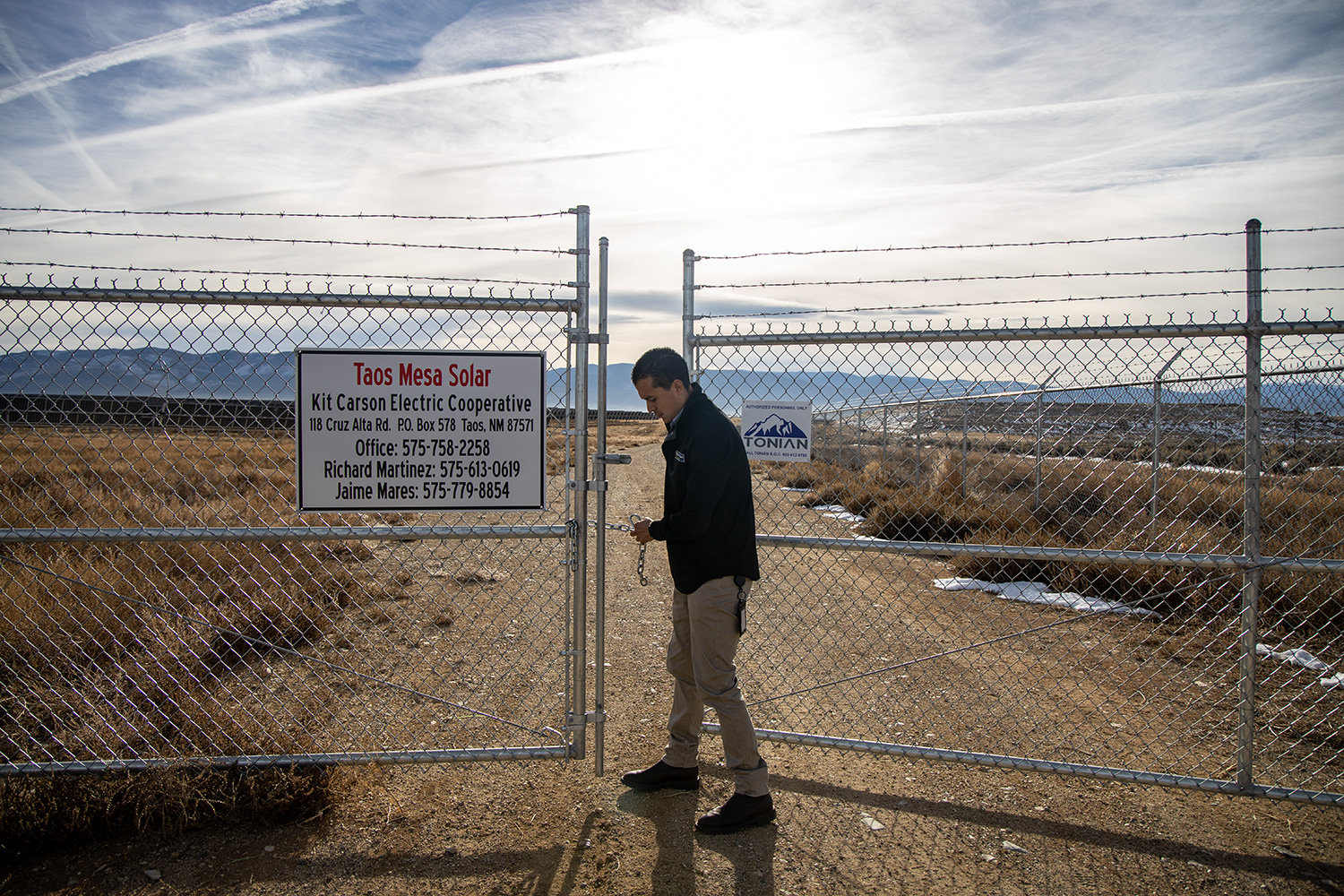 Kit Carson’s largest solar array, near Taos, New Mexico. Credit: Juan Antonio Labreche / High Country News
Kit Carson’s largest solar array, near Taos, New Mexico. Credit: Juan Antonio Labreche / High Country News
Renewable Taos began attending Kit Carson’s board meetings with a new goal in mind: moving the entire service area to 100 percent renewable energy if the Tri-State contract was broken. “We didn’t align at all,” Reyes recalled. The board thought Renewable Taos, some of whose members were well-to-do retired scientists, were “kind of telling us dummies what to do,” he said, with a chuckle.
But Reyes and the board found a way to address that tension. “At the end of our first meeting (with Renewable Taos), I suggested to the board, well, if these guys are really going to help us and be critical, let’s give ’em some homework,” he said. The board asked Renewable Taos to visit every municipality Kit Carson served to build support for a joint resolution declaring that all co-op members were committed to fighting climate change.
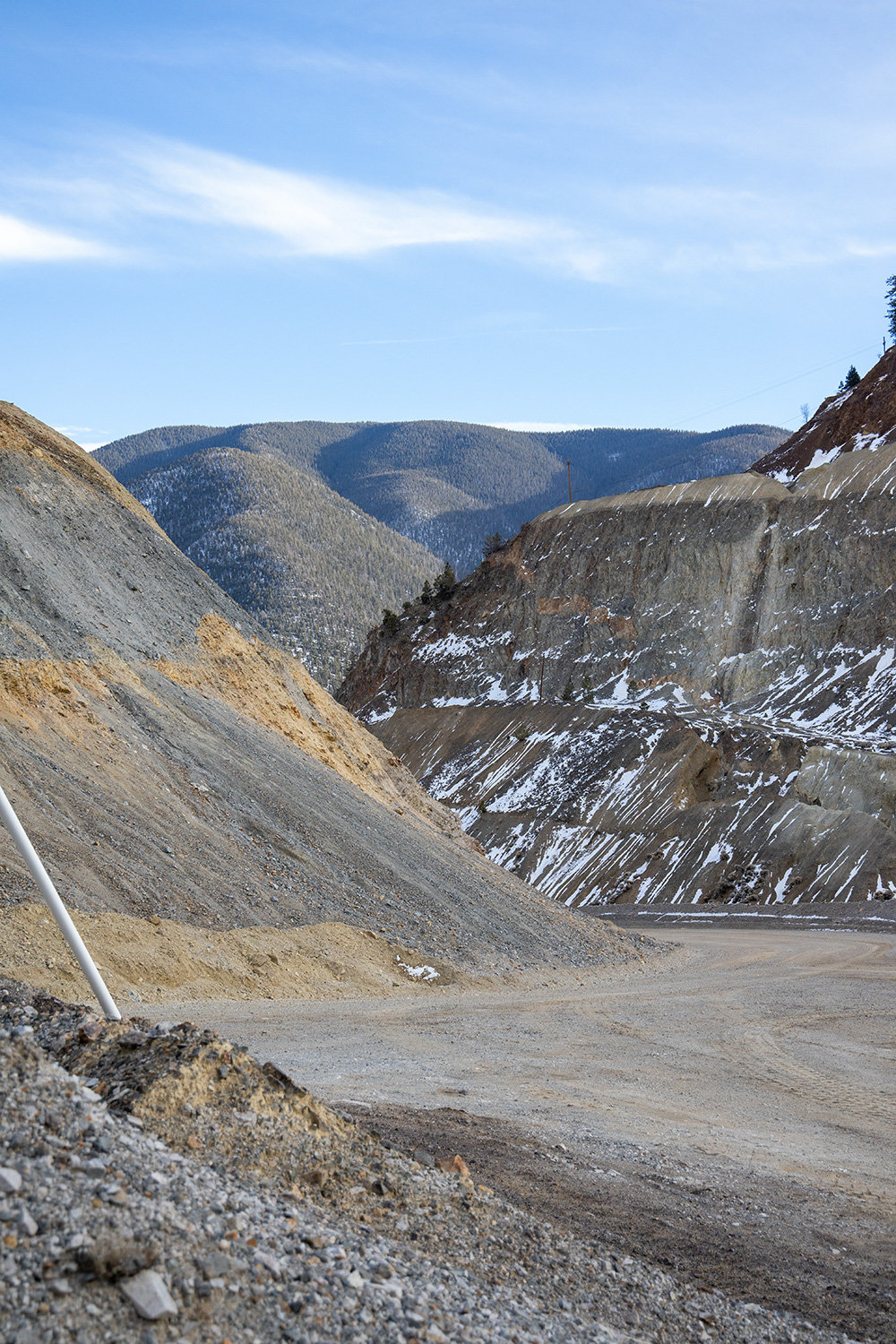 A shuttered molybdenum mine in Questa, New Mexico, would be the site of a new green hydrogen plant. Credit: Juan Antonio Labreche / High Country News
A shuttered molybdenum mine in Questa, New Mexico, would be the site of a new green hydrogen plant. Credit: Juan Antonio Labreche / High Country News
Jay Levine, one of the original Renewable Taos members, still wonders if that was an attempt to put them off politely. Even so, the group accepted Reyes’ challenge, visiting every municipality in Kit Carson’s service area and answering questions about renewables and energy costs. “We talked to a lot of folks, and I think everywhere we went, they signed on,” he said. The process was aided by the falling cost of solar energy, which began reaching price parity with coal in the mid-2010s.
By 2014, every community in Kit Carson’s service area had signed on to Renewable Taos’ clean energy resolution. Two years later, after the co-op board finally found an alternate energy supplier, it broke its Tri-State contract for $37 million. Thanks to increased control over its power sources, Kit Carson reached an important goal in 2022: Renewable energy now provides 100 percent of the year-round daytime electrical needs of its more than 30,000 members.
Now, other co-ops, notably Delta-Montrose in western Colorado, are following Kit Carson’s lead and leaving Tri-State in the name of clean energy.
Levine, the Renewable Taos member, said that Kit Carson’s long struggle paved the way for other co-ops to leave Tri-State. “That (trend) literally wouldn’t have happened,” he said, “because nobody else would have had the guts to do it.”
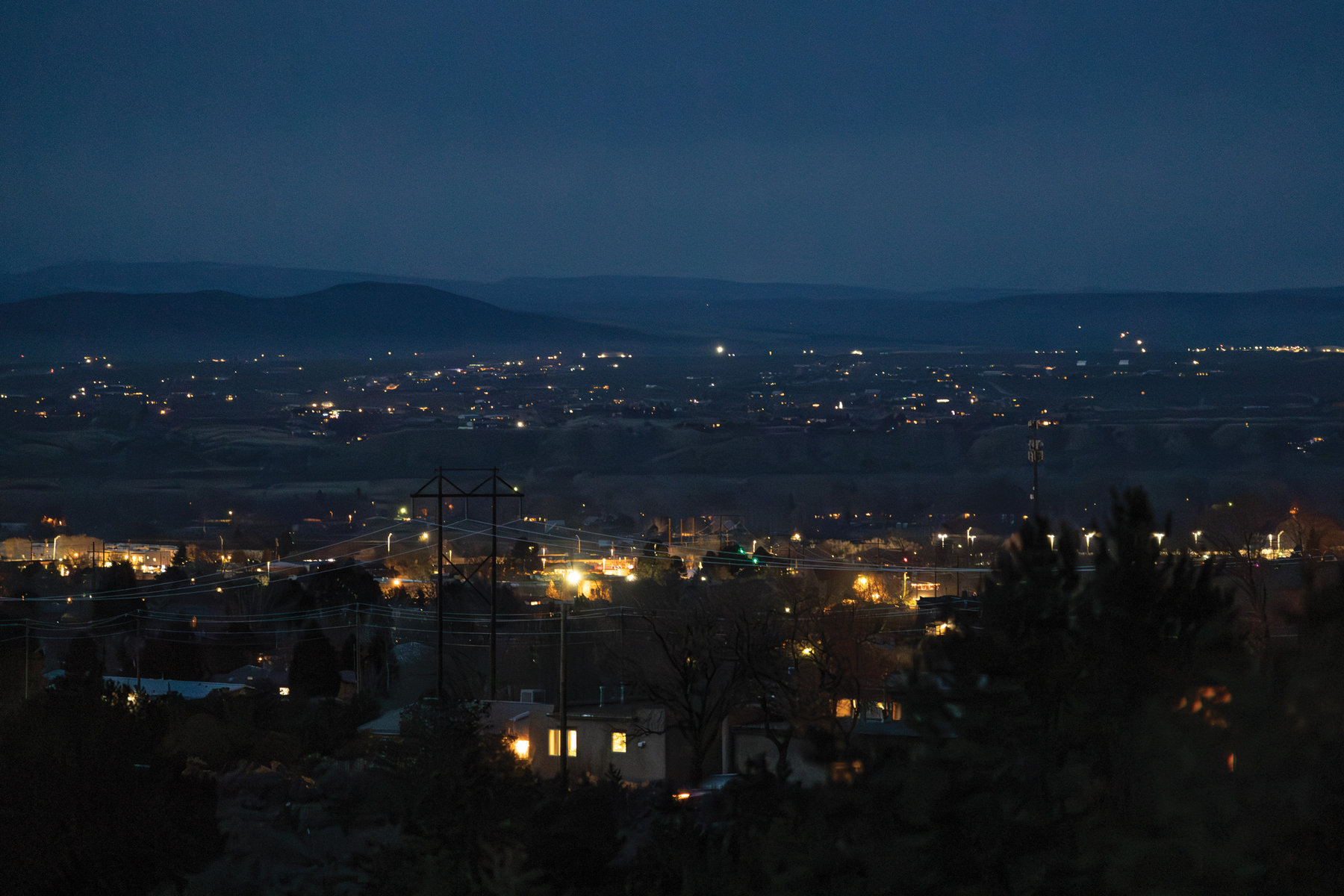 Energy users in the Taos area. Credit: Juan Antonio Labreche / High Country News
Energy users in the Taos area. Credit: Juan Antonio Labreche / High Country News
The co-op’s achievement — hitting the 100 percent daytime clean energy milestone — is clearly significant, but it also needs to meet a New Mexico mandate that rural co-ops transition entirely to carbon-neutral electricity by 2050. One potential pathway involves a green hydrogen plant that the co-op has explored with the National Renewable Energy Lab, other government partners and the small village of Questa.
Conventional hydrogen production, which uses fossil fuels, contributes to climate change, but so-called green hydrogen can be produced by splitting water atoms with an electrolyzer powered by renewable energy. Proponents think widespread green hydrogen could reduce US carbon dioxide emissions by 16 percent by mid-century. Despite all the investment and hype, however, few green hydrogen projects have broken ground. Still, Kit Carson has beaten the odds before; Reyes recalled that many people doubted that the co-op would ever reach its goal of meeting daytime energy needs with 100 percent renewables.


Become a sustaining member today!
Join the Reasons to be Cheerful community by supporting our nonprofit publication and giving what you can.
The Questa plant would be built at a shuttered molybdenum mine, which operated from the 1920s until 2014 and was a major source of both jobs and pollution. In 2005, a Chevron subsidiary, Chevron Mining, acquired Unocal, the mine’s parent company. Today, Chevron manages the remediation of what is now a Superfund site.
At a series of local meetings, water was the top concern for Kit Carson members. A variety of sources could be used to power the proposed plant, including water that Chevron is already pulling from the underground mine, treating, and sending to the Red River as part of its Superfund mitigation. Reyes is optimistic about the hydrogen project, describing it as the next phase of Kit Carson’s clean energy journey. But he noted that the future of the project, and of the co-op as a whole, ultimately lies in the hands of the co-op’s members. “They have been part of that equation the whole time,” he said.
The post The New Mexico Electricity Co-op Breaking Up With Fossil Fuels appeared first on Reasons to be Cheerful.
Solar Pumps Are Empowering Women Farmers in India
Narrow roads lead to Harpur, flanked by small houses with expansive courtyards on both sides. Harpur is a small village perched at one corner of the Bandra block in Muzaffarpur district in the Indian state of Bihar, and though it may look like any other rural village, it is home to a group of women farmers who are at the forefront of a revolutionary change.
Historically, this region has grappled with water scarcity, which sharply limited the crops that farmers could cultivate. But since women-led self-help groups stepped in and installed solar pumps to provide affordable clean energy for irrigation, the scenario has changed dramatically. And along the way, these groups are challenging traditional gender norms, making women farmers a catalyst for climate adaptation.
The post Solar Pumps Are Empowering Women Farmers in India appeared first on Reasons to be Cheerful.
With Boomers Retiring, Worker Co-ops Are on the Rise
Three great stories we found on the internet this week.
Teamwork
In the years ahead, more and more baby boomers will retire, some of them without plan for who will run their businesses. One response to this “silver tsunami”: creating worker-owned cooperatives. In worker co-ops, the workers run the business and keep the profits. This has been shown to result in better pay than traditional businesses — and more productivity, too.
 Credit: Brian O’Doherty
Credit: Brian O’Doherty
Case in point: When the owner of Baltimore’s Common Ground Cafe retired and closed the shop last summer, its employees banded together and quickly began to organize. In the first six weeks after the cafe reopened as a worker co-op, Common Ground was able to raise wages by up to 25 percent.
Reopening as a co-op “was the best feeling in the world,” barista Sierra Allen told Yes! Magazine, “because we get to see our customers, we get to spend time with one another, and when we see issues, we can fix them the way we see fit.”
Under the sun
Solar power has become the cheapest form of energy in the world, making it an appealing option for Native American tribes who lack reliable access to electricity. That — along with the impacts of fossil fuels — is why Cody Two Bears, member of the Sioux tribe in North Dakota, started building solar farms.
Two Bears is the founder of Indigenized Energy, which installs free solar farms for tribal nations. A 1,100-panel solar farm that Indigenized Energy built in Cannon Ball, on the Standing Rock reservation, produces enough energy to power 60 homes and saves the tribe up to $10,000 per year.
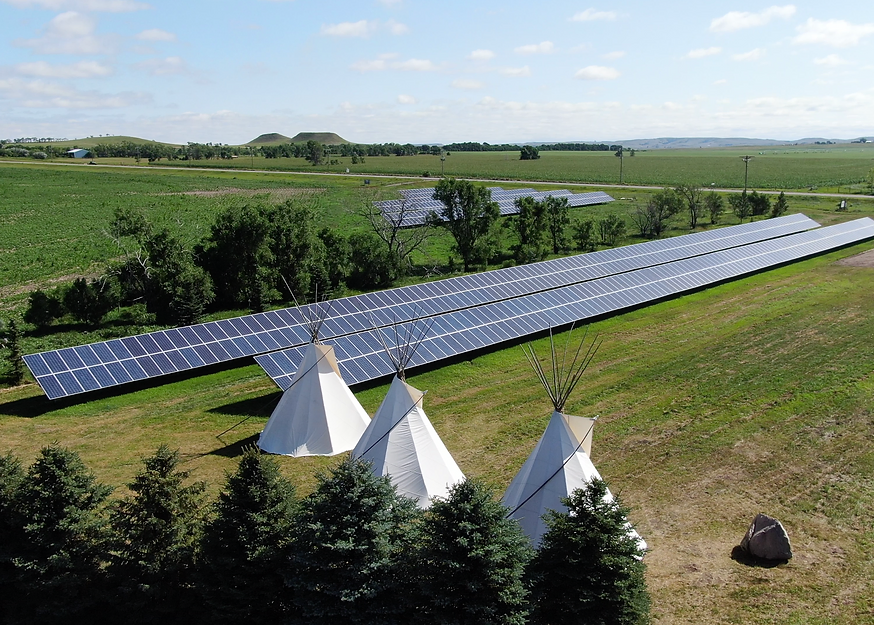 Courtesy of Indigenized Energy
Courtesy of Indigenized Energy
When reservations were created, the government intentionally placed many of them on land that wasn’t good for farming. But now, because the tribes have been such good stewards of the environment, much of that land is ideal for renewables. “Some of the lands that were the worst lands 160 years ago are now some of the most pristine because our tribal nations have protected and preserved them,” said Two Bears.
Free reads
A new major book award has launched in the US with a unique jury: 300 incarcerated people. Created by Freedom Reads, the National Book Foundation and the Center for Justice Innovation, the competition is a way for those serving sentences “to meaningfully participate in our shared national cultural conversation,” Freedom Reads CEO Reginald Dwayne Betts said in a press release.
Crushed by negative news?
Sign up for the Reasons to be Cheerful newsletter.
[contact-form-7]
The finalists are Tess Gunty, Jamil Jan Kochai, Roger Reeves and Imani Perry. Before the winner is announced in June 2024, incarcerated people will also be able to participate in live discussions and literary readings.
John J. Lennon, a writer who is serving a life sentence, was involved in planning the award and is serving as a juror. “The award just tells us, hey, we can add meaning, it shows us that our word can count too,” Lennon said.
The post With Boomers Retiring, Worker Co-ops Are on the Rise appeared first on Reasons to be Cheerful.
The Galapagos Are Going Green
Just three blocks up from a seafront packed with hooting and howling Galapagos sea lions — adolescents chasing each other through rock pools, alpha males snoring in the midmorning sun and mothers teaching their pups how to swim — the daily market on the island of San Cristóbal is serving up its own endemic specialities.
Piles of ruby-red tomatoes, pinkish papayas and hulking great oranges line Marina Herrera’s stall. Beside them are bunches of thick plantains, sweet, finger-sized local bananas, as well as chunky chili peppers and heads of fresh lettuce.
“They’re all grown within a few kilometers of here,” says Herrera, a 73-year-old Galapagueña trader known by locals as Chambita. “The oranges come from Cerro Verde [a nearby mountain]. It’s cheaper than imported food. And it’s tastier.”
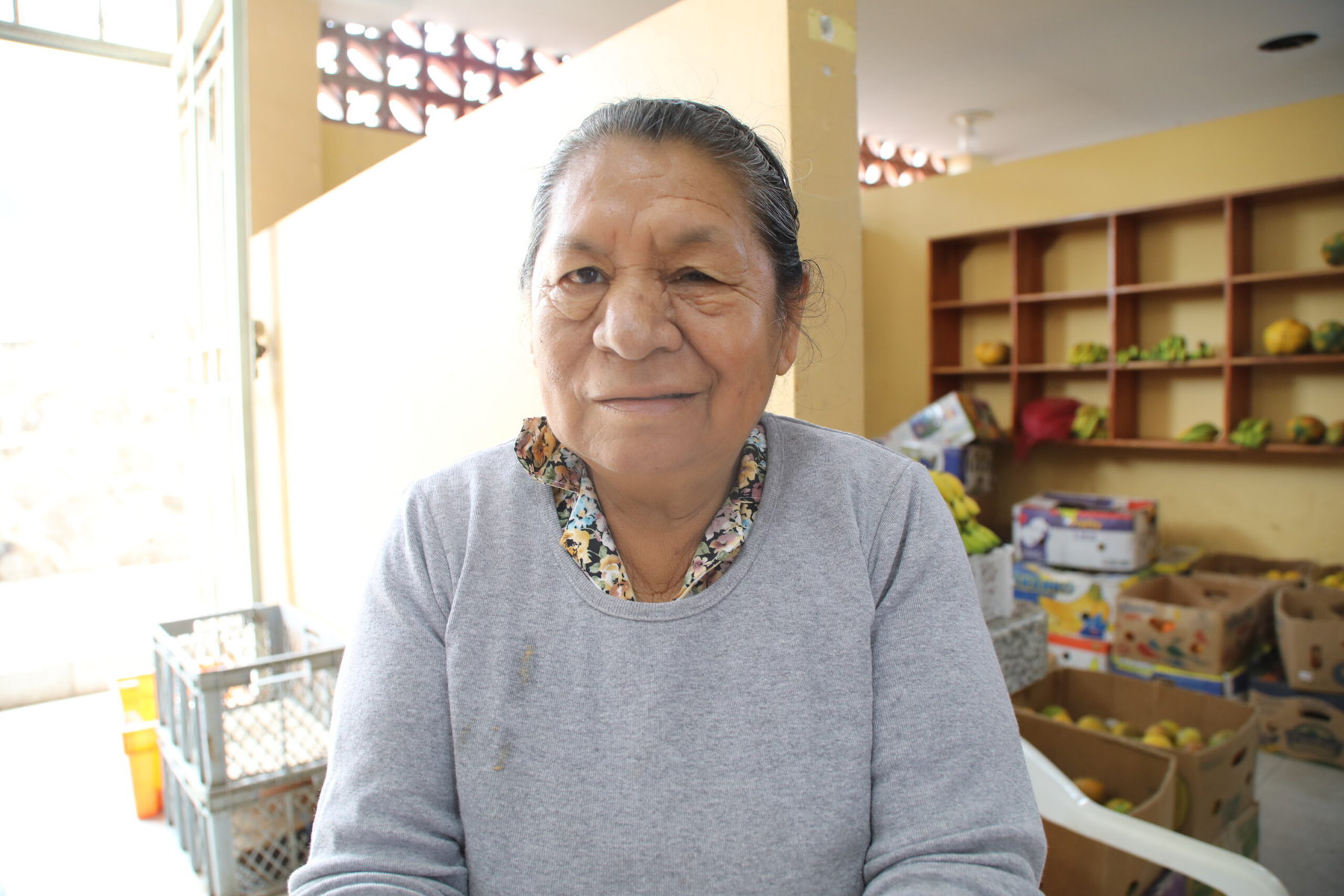 Marina Herrera. Credit: Peter Yeung
Marina Herrera. Credit: Peter Yeung
Herrera and her fellow stall holders are part of a community-led effort to transform the Galapagos Islands into a model of self-sufficiency, with their initiatives ranging from localized food systems to nature-based water treatment, renewable energy production, and a more equitable approach to the archipelago’s ecotourism.
The Galapagos Islands, a UNESCO World Heritage site, is the second-largest marine reserve in the world, and its remarkable abundance of wildlife found nowhere else on the planet inspired Charles Darwin’s groundbreaking Theory of Evolution.
The so-called Enchanted Isles are home to thousands of species, including more than 15 varieties of giant tortoise, the world’s only marine iguana, the only penguins found north of the equator, the ocean’s highest concentration of hammerhead sharks, pink flamingos, as many as 50,000 sea lions, and unique flora such as the lava cactus, a hardy species that is the first to grow after a volcanic eruption.
The post The Galapagos Are Going Green appeared first on Reasons to be Cheerful.